If you’re a beginner hiker, chances are you know how physically demanding hiking is.
This strenuous activity doesn’t just move your lower body; it also uses your upper body, especially when carrying heavy gear and supplies up on a high-altitude trail.
On the upside, hiking promotes a healthy lifestyle. It improves your overall well-being and reduces your chances of getting sick from cardiovascular disease.
When you move each part of your body, your heart pumps blood to supply your limbs with oxygen that is needed by the muscles.
Speaking of limbs, we use our legs to walk or climb up a trail. Because of this reason, our energy will be directed more to our legs than other parts of our body.
With many rigorous exercises, we see changes in shape or strength whenever we use those muscles frequently. But does the same thing happen with hiking?
To be exact, does hiking build leg muscle?
Hiking can build our leg muscles. When you hike, not only will you carry your own body weight, but also all the necessary equipment needed for your journey. Combined with gravity, wind resistance, and the harsh terrain you’re about to encounter, more challenges will be put on your legs. Simply put, the more challenging the trail gets, the more leg muscle you could build.
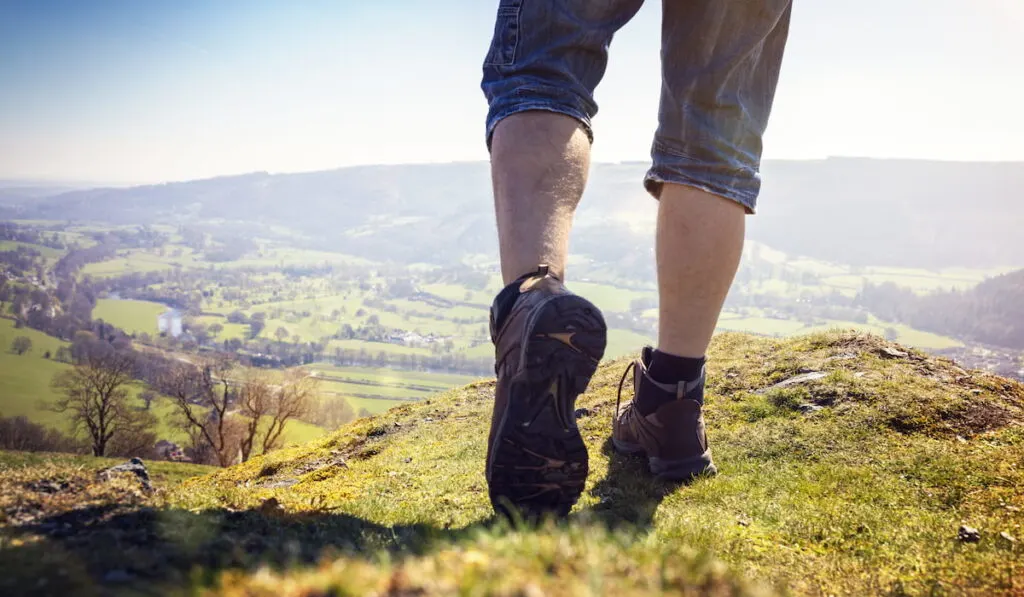
Before we explore how hiking is related to the growth of leg muscles, let’s first discuss the anatomy of our legs and the muscles around them.
Table of Contents
The Anatomy of Leg Muscle
Humans are nimble Homo sapiens that walk with both legs. Although Darwinian science hypothesized that we are closely related to most primates, we are the only bipedal creatures that don’t require other limbs to move freely.
With our legs, we can run, walk, jump, climb, or even swim.
There are three important groups of muscles that are responsible for carrying our body weight when we move. They are the quadriceps, hamstrings, and calves.
Quadriceps
Quadriceps are made up of four major muscles: vastus lateralis, vastus medialis, vastus intermedius, and rectus femoris. But the biggest muscle that contributes to our movement in this group is vastus lateralis.
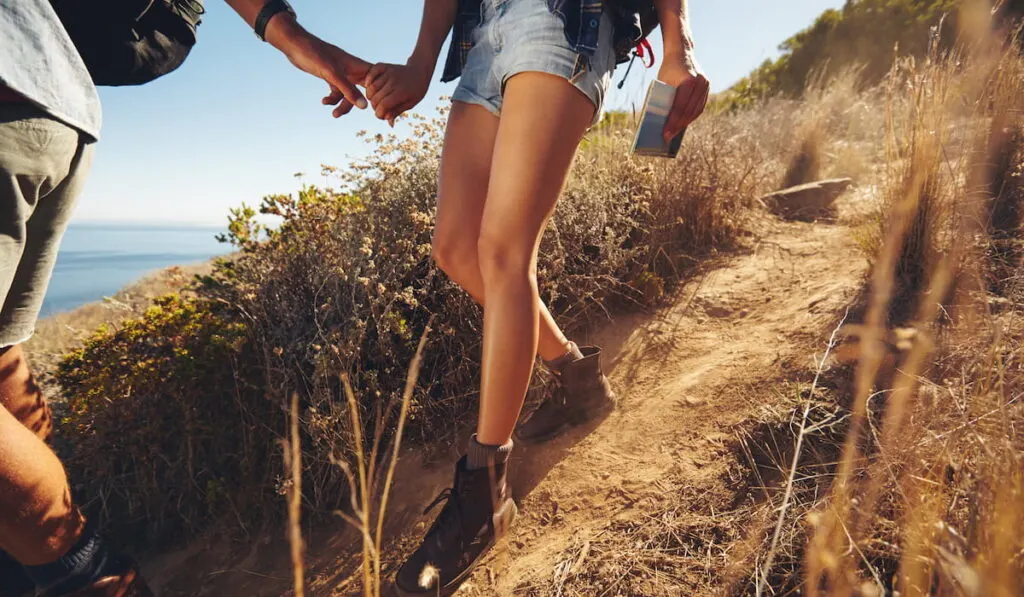
Hamstrings
Meanwhile, hamstrings are made up of three muscles: biceps femoris, semimembranosus, and semitendinosus. Most of these muscles contribute to rotation, angular movement, and support for hip and knee areas.
Calves
Finally, calves consist of another three muscles, which are the gastrocnemius, soleus, and plantaris.
All of these three muscle groups will work synchronically to move and pivot our movement. If we hurt any part of these muscles, it will be much harder to walk, jump, or even run normally.
Upper Leg and Hip Muscles
Additionally, there are also other muscles located on the upper part of our legs that contribute to the better movement of our legs.
These include three hip flexor muscles (iliacus, psoas major, and rectus femoris), the glute muscles at the hip joints (gluteus minimus, gluteus medius, and gluteus maximus), and muscles known as adductors, which are in the thighs.
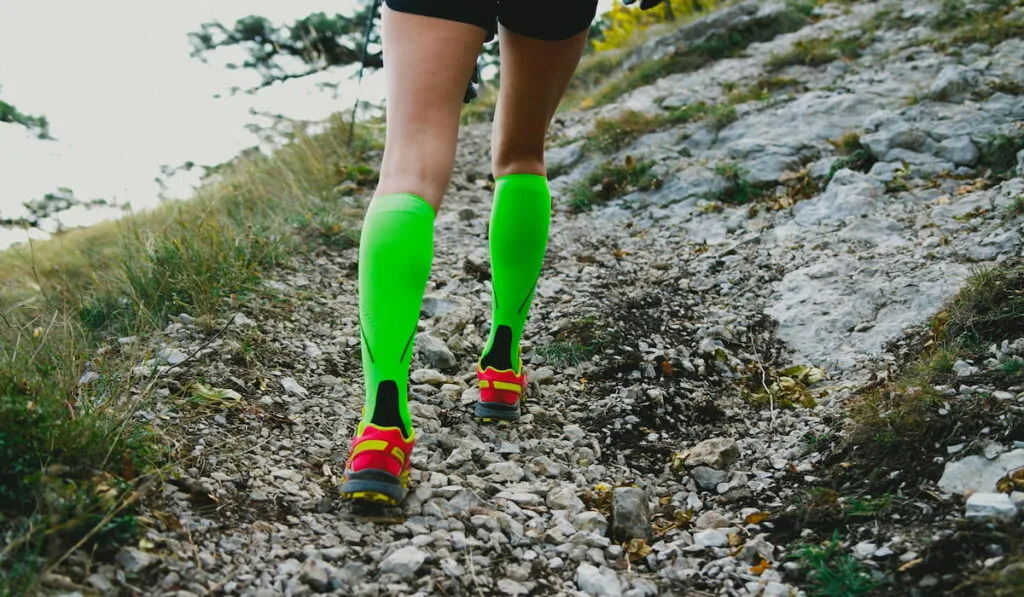
Which Leg Muscle Is Used For Hiking?
Because our leg muscles work together to support our body during walking or running, no single muscle is used for hiking.
Our quadriceps, hamstrings, calves, glutes, hip flexors, and even the muscles on our ankles provide all the necessary mechanics that allow us to hike.
The large muscles of our legs, such as the quadriceps, followed by the hamstrings, will do most of the heavy work during hiking. They are responsible for stretching and extending our legs, bending our knees during hiking up to a higher altitude, and walking on rocky terrain.
Similar things happen to the calves and glutes. More stress from body weight will be put on the calves and glutes during a walk or run uphill.
However, on a flat surface, they won’t be put to work as hard as the quadriceps and hamstrings.
What Makes Our Leg Muscles Grow During Hiking?
Any rigorous exercise will allow us to build muscle.
If you often work out at the gym, you will know how important muscle growth is for your physical strength and endurance.
The same thing happens with hiking. Muscular hypertrophy will occur when we put a certain amount of stress or load on our leg muscles during hiking.
A scientific term, hypertrophy can be defined as an increase in muscle mass, size, and strength after rigorous training. To achieve muscular hypertrophy, you must undergo heavy resistance training to tear your muscle fibers.
These micro-tears don’t necessarily mean that your muscles are injured or hurt. But oftentimes, you will feel a slight soreness around the muscles right after you finish strenuous exercise.
When the fiber of your muscles tears, all the surrounding cells will encounter inflammation that leads to a trigger mechanism. This will allow your body to repair all the damaged and torn fibers using hormones such as testosterone, insulin, and other growth hormones.
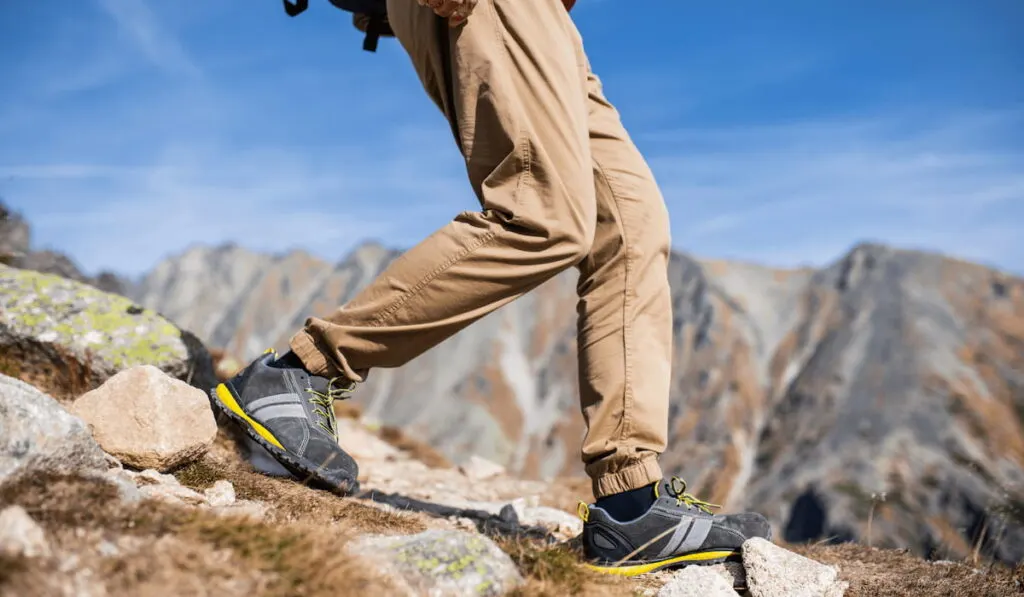
Over time, when this process is repeated over and over again, new fibers will be produced upon the old ones, causing your muscle mass to grow.
The recovery process will also use all the nutrition you put in your body. Hence, having a healthy and balanced diet will also contribute to the growth of your leg muscle.
With hiking, your legs are the primary limbs used to carry your weight up a steep track. As you increase the altitude, your hiking speed, and the load you have on your back, more stress will be put on your leg muscles.
The same thing happens when you’re going down the hill. Muscular hypertrophy doesn’t just occur when you’re hiking up the mountains.
Hypertrophy will happen whenever your leg muscles are being used rigorously to the point of microscopically tearing.
The only thing that separates hiking up or down the trail is the muscles involved. When hiking uphill, you will use your hamstrings, glutes, calves, and ankles more. But when hiking downhill, your glutes and quadriceps will work the most.
How to Prevent Leg Injury When Hiking
Hiking can be fun and challenging. It is also an alternative to resistance and intense workouts that you can always do at the gym.
However, like many exercises, it is advisable for you to take precautionary steps to prevent injuries that may hinder your progress or, worse: prevent you from doing this in the long run.
Here are some tips on how to prevent leg injury when hiking.
Exercise Regularly

It goes without saying that the more you exercise, the better your body adapts to changes in movement during hiking. If possible, try to allocate at least one or two hours every week to do some leg exercises.
You can go to the gym and utilize all the leg machines, such as the stair climber, treadmill, rowing machine, leg extension, and many more.
If you’re looking to increase your leg strength, go for resistance training that uses weights, such as barbell squats, dumbbell squats, pistol squats, dumbbell lunges, and Bulgarian squats.
The stronger your legs get, the lower your chances of getting injured during your hike.

Do Some Light Stretches
Before you hike, it is advisable for you to do some light stretches.
Move your hands, hips, legs, and other parts of your body in a circular motion to promote better blood flow. You can also focus more on your legs, especially bigger muscles such as quadriceps and hamstrings.
Avoid sudden or rapid movement during your stretch.
But take your time and breathe deeply so that your body will receive enough oxygen. The last thing you want to have is muscle cramps or sprained ankles due to your habit of not stretching your legs before hiking.
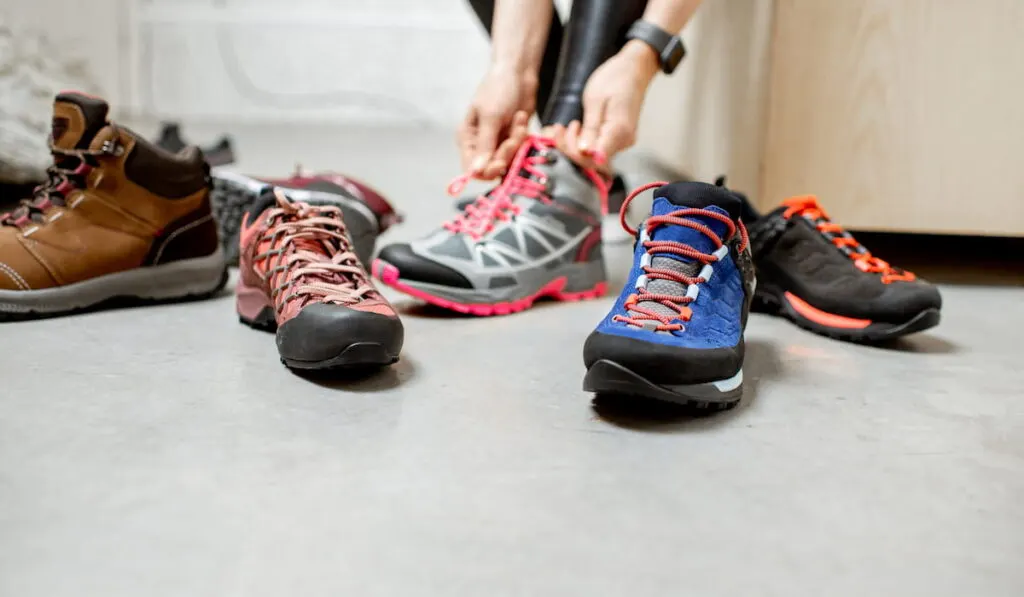
Wear the Right Shoes
Your shoes also play a significant role when you hike up the track. Most hiking footwear provides better support and balance for your legs.
Properly fitted shoes can prevent minor injuries around your ankles, such as bruises, scrapes, or even blisters.
Always keep track of the condition of your shoes. If your footwear doesn’t provide enough grip or support, you risk falling when hiking on slippery slopes or rocky terrain.
If possible, keep your socks dry and bring an extra pair, just in case the weather changes.
Take a Quick Break
Although you might have a target to reach the peak or your destination at a set time, it will be much better for you to take a quick five-minute rest in the middle of your hike.
There is no one who would force you to keep walking if you’re feeling tired.
Take a breather and sip some water for refreshment.
During this break, you are also allowing your leg muscles to relax from all the loads that you carry on your back.
Use Trekking Poles
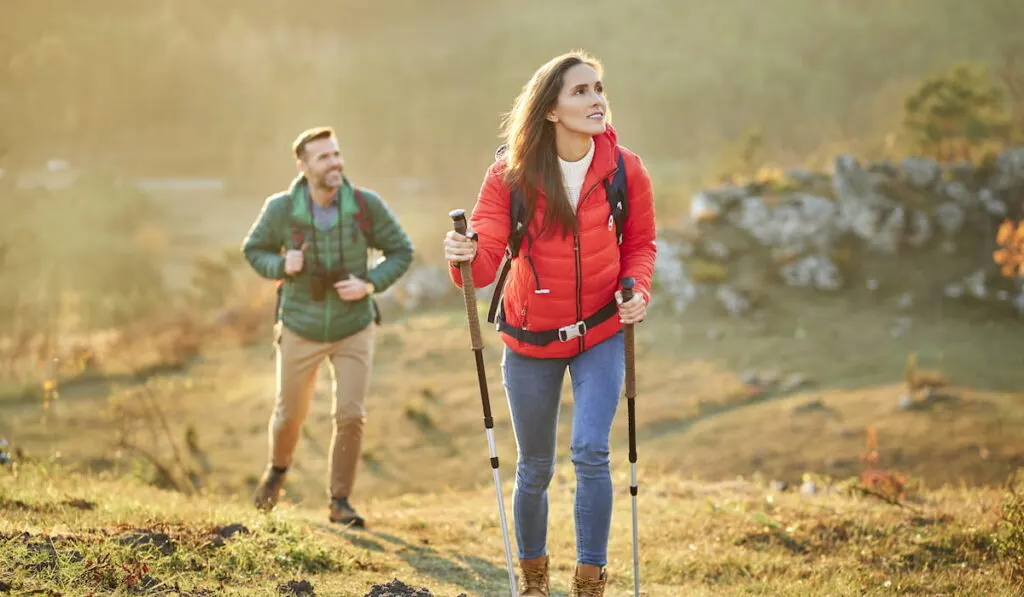
Trekking poles are great hiking gear that you can use during your hike. This equipment is usually made from lightweight steel or aluminum.
Trekking poles can provide extra support for your upper body and legs, especially for your knees.
Aside from stability, when you use trekking poles, you don’t have to frequently bend when walking up on steeper terrain. This way, you can improve your posture and avoid straining your back.
Get Enough Sleep and Eat a Proper Diet
Rest, recovery, and a healthy diet go hand in hand. You can’t have one without the other two.
Get enough sleep during the night before your hike. Eat nutritious food during the week before your hike. Stay hydrated by carrying enough water bottles during your journey.
And finally, when you are finished hiking, get enough rest before deciding to go for your next hike.
Final Thoughts
Overall, any types of exercises that require you to use your legs will affect the muscles around them. This also includes light exercises such as brisk walking and slow jogging.
What contributes to the growth of your leg muscles is how intense and how frequent the exercise is.
If you’re a beginner hiker, it will take some time for your legs to adapt to all the strenuous hikes up the trail. But over time, you will get to the same level as all the experienced hikers.
Resources
- https://www.healthline.com/human-body-maps/leg-muscles#2
- https://morninghiker.com/will-hiking-build-leg-muscle/
- https://hikeheaven.com/can-you-build-muscle-while-hiking/
- https://cahikingadventures.com/can-hiking-build-muscle/
- https://gearuphiking.com/does-hiking-build-muscle/
- https://totalhiker.com/what-muscles-does-hiking-work/
- https://www.medicalnewstoday.com/articles/muscle-hypertrophy#tips-and-suggestions

